‘Assembly Halls‘ is the term used to refer to the ‘community houses‘ of the overseas Chinese (Hoa Kiều) in Hoi An during the 17th to 18th centuries. These assembly halls were constructed by the Chinese community to meet, socialize, trade, and support each other in their daily lives. Nowadays, these assembly halls have become fascinating tourist attractions. When visiting Hoi An for tourism, along with exploring the ancient streets and enjoying the local cuisine, DanangPrivateCar.com’s recommends that you don’t miss the chance to visit the top 5 assembly halls in Hoi An.
Introduction to the top 5 assembly halls in Hoi An.
Hoi An is an ancient town located in the lower reaches of the Thu Bon River in the coastal plain of Quang Nam province. During the 17th to 18th centuries, this place, with its favorable climate and geographical location – having both a river, a seaport, and bustling streets – became a thriving international trading port, bustling with activity on both land and water.
Traders from Japan, the Netherlands, Spain, China, and others came to Hoi An for trading and business activities. Hoi An gradually became a place of residence and business for a significant part of the Chinese community. The overseas Chinese community in Hoi An frequently met and gathered, leading to the emergence of a need for a “community house.”
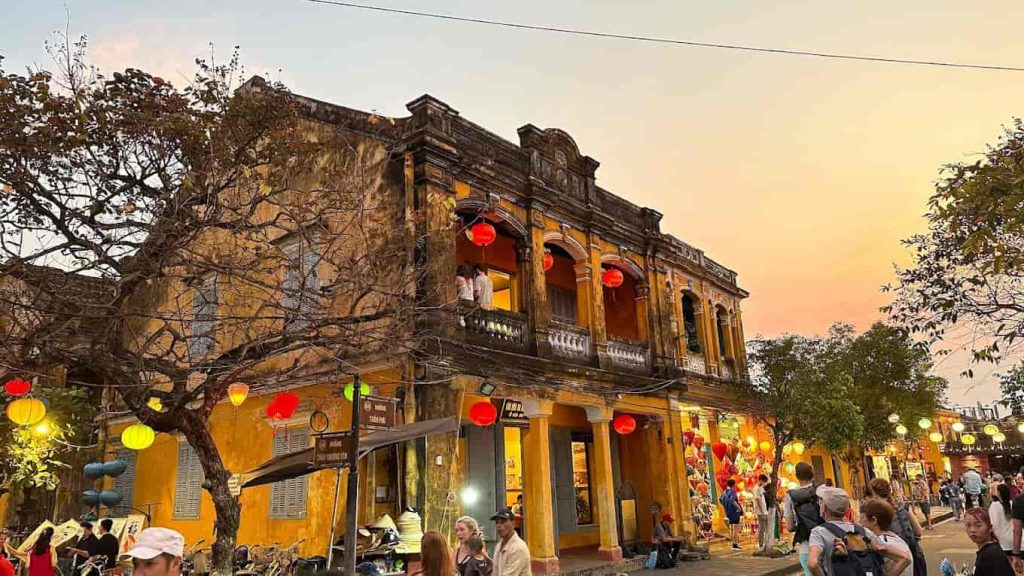
During this time, they constructed assembly halls as places for communal gatherings and spiritual activities. Until today, these architectural structures still retain their ancient charm, harmony, and add to the serene and ancient beauty of Hoi An’s streets.
The top assembly halls in Hoi An consist of five such halls, but rest assured that you won’t need to spend too much time to explore all of them. All five assembly halls are located right in the center of Hoi An. Visitors won’t have to spend much time traveling, as it takes just over an hour to discover all five ancient assembly hall architectures. These assembly halls are situated along the central axis of the ancient town, starting from Nguyen Duy Hieu street and extending to the end of Tran Phu street.
Do you want to visit Hoi An’s ancient town and explore the assembly halls? Book your trip from Da Nang Airport to Hoi An with our private car service, offering fast and safe transportation.
The ideal time to explore the top 5 assembly halls in Hoi An.
If you are a travel enthusiast who loves history, culture, and enjoys checking in at various tourist destinations, then Hoi An is the perfect place for you. When you visit Hoi An, don’t miss the chance to explore the assembly halls.
All the assembly halls are indoor tourist attractions, so visitors can visit them at any time of the year, depending on their schedule and time availability. Each season, Hoi An adorns itself with its own beauty, attracting travelers from far and wide.
- Rainy season (approximately from September to December every year): If you visit Hoi An during this time, you will get to see the ancient town immersed in light drizzles of afternoon rain. The moss-covered tile roofs and ancient yellow walls will be even more charming with a touch of time, creating an extremely deep, gentle, and incredibly romantic atmosphere.
- Dry season (approximately from March to December every year): DanangPrivateCar’s believes that this is the best time for tourists to come to the ancient town and explore Hoi An’s assembly halls. The weather during this time is sunny throughout the day and there is less rain. You will find it easy to move between different tourist attractions.
- During the beginning of spring, New Year, and Tet holidays: You can also choose to visit Hoi An and explore the assembly halls during these occasions. In the ancient town, the assembly halls, ancient pagodas, and temples often organize many festivals that attract travelers from all over during the Lunar New Year and Tet holidays.
Opening hours and ticket prices for visiting the assembly halls in Hoi An.
Opening hours: The assembly halls in Hoi An are open to visitors every day of the week, from 7:00 AM to 5:00 PM daily.
Ticket prices:
- Duong Thuong Assembly Hall, Hai Nam Assembly Hall: Free.
- Quang Dong Assembly Hall, Phuc Kien Assembly Hall, Trieu Chau Assembly Hall: 80,000 VND for a ticket covering all three locations.
If you are looking for travel transportation in Hoi An, don’t worry! DanangPrivateCar.com provides private car rental services with professional drivers in Hoi An. With a team of experienced drivers who have transported international passengers for many years, we will ensure you have the safest and most comfortable journey.
DanangPrivateCar.com will take you to discover the beauty of the top 5 assembly halls in Hoi An.
It can be said that these assembly halls are the “companions” that have accompanied Hoi An through many ups and downs, and the changes of the times. Because all these assembly halls have been built for hundreds of years, from the time when Hoi An was a prosperous trading port to the world-famous ancient town and now a UNESCO-recognized cultural heritage.
The assembly halls in Hoi An are not merely places of worship and spiritual activities for the overseas Chinese but have also become famous tourist destinations.
Phuc Kien Assembly Hall
- Address: 46 Tran Phu Street, Minh An Ward, Hoi An, Quang Nam.
The reason DanangPrivateCar.com introduces this as the first assembly hall is that among the 5 ancient assembly halls in the Old Quarter, Phuc Kien Assembly Hall is the largest one, representing profound East Asian philosophy on human happiness and attracting the most visitors.
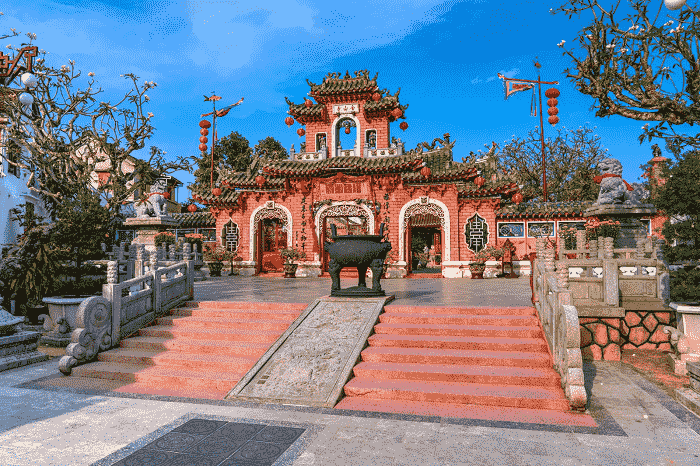
Originally, Phuc Kien Assembly Hall in Hoi An was a small temple built in 1697 to worship the Goddess Thien Hau. Through multiple renovations and contributions from the Chinese community in Hoi An, the assembly hall has expanded over the years.
The architecture follows the Three-Compartment style, including the Three-entrance Gate, Courtyard, Two rows of houses East-West, Main Sanctuary, and Back Sanctuary. The architectural style is exquisitely crafted, representing the Chinese architectural style, while harmonizing with the ancient beauty of Hoi An.
Quang Dong Assembly Hall
- Address: 176 Tran Phu Street, Minh An Ward, Hoi An, Quang Nam.
The next assembly hall among the 5 in Hoi An that DanangPrivateCar.com wants to introduce is the Quang Dong Assembly Hall (also known as Quang Trieu Assembly Hall).
This assembly hall was constructed in 1885 with contributions from the Chinese community from Quang Dong province. Originally, it was built to worship Thien Hau Thanh Mau (the Goddess of the Sea) and Confucius.

Since 1911, the Quang Dong Assembly Hall has been used to worship General Guan Yu and Thien Ly Nhan. The Quang Dong Assembly Hall is designed with a combination of stone and wood, creating a grand, solemn, and splendid space.
In front of the assembly hall, there is a large water pond with a floating dragon-shaped sculpture representing the symbol “a carp transforms into a dragon.” This place still preserves many artifacts made of ceramics and writings documenting the life of the Quang Dong community in Hoi An.
Duong Thuong Assembly Hall
- Address: 64 Tran Phu Street, Minh An Ward, Hoi An, Quang Nam.
Duong Thuong Assembly Hall is also known as the Chinese Assembly Hall or the Five-Clan Assembly Hall (due to the contributions from five Chinese clans: Gia Ung, Phuc Kien, Trieu Chau, Hai Nam, and Quang Dong) during its construction in 1741.
Although it was established later than the other assembly halls, Duong Thuong Assembly Hall still affirms its role and unique characteristics. The original purpose of Duong Thuong Assembly Hall was to worship 108 Chinese merchants known as “Nghia Liet Chieu Ung.”

The architecture of Duong Thuong Assembly Hall is designed in the shape of the character “Quoc” (国) and has a large scale, including the Front House, Main Sanctuary, and two Houses East and West. The Main Sanctuary is a magnificent and solemn space with large columns standing on marble pedestals.
Hai Nam Assembly Hall
- Address: 10 Tran Phu Street, Minh An Ward, Hoi An, Quang Nam.
Hai Nam Assembly Hall (also known as Quynh Phu Assembly Hall) was built in 1875 with contributions from the Chinese community from Hai Nam province.
Although established later than the other assembly halls, Hai Nam Assembly Hall still preserves its significant role and distinct features. Initially, Hai Nam Assembly Hall was built as a place of worship for 108 Chinese merchants known as “Nghia Liet Chieu Ung.”

Hai Nam Assembly Hall is designed with a “Quoc” (国) shape, with a large scale including the Front House, Main Sanctuary, and two Houses East and West. The Main Sanctuary is a grand and solemn space with large columns standing on marble pedestals.
Trieu Chau Assembly Hall
- Address: 157 Nguyen Duy Hieu Street, Cam Chau Ward, Hoi An, Quang Nam.
While the other 4 assembly halls are located on Tran Phu Street, Trieu Chau Assembly Hall is situated on Nguyen Duy Hieu Street, heading towards Cua Dai Beach.
It was built in 1845 and is dedicated to worshiping Phuc Ba – the deity specialized in controlling the sea and praying for safe and smooth voyages for sailors.
Like other assembly halls in Hoi An, Trieu Chau Assembly Hall was established to meet the needs of community gatherings and cultural-spiritual activities of the overseas Chinese at that time. It is one of the special architectural works in the ancient architectural complex in Hoi An.
Every year, on the 16th of the first lunar month, Trieu Chau Assembly Hall holds ceremonies to celebrate the Yuanxiao Festival and commemorate the ancestors, attracting many visitors from different regions and Trieu Chau Chinese community in Hoi An and neighboring provinces to participate.
The exciting experiences await you when visiting the Top 5 assembly halls in Hoi An.
Today, the assembly halls in the ancient town are carefully preserved and have become famous tourist attractions. They are all located close to each other, making it convenient for visitors to explore. What will you experience here?
Learn about history and discover unique architecture.
The assembly halls in Hoi An are places for community activities, worshipping patron deities, and ancestral figures from different provinces. Therefore, those who love culture and history will have the opportunity to learn and enrich their knowledge.
You will learn about the history of their establishment, the origins of their names, and the specific renovations and repairs of each assembly hall. For example, when exploring Phuc Kien Assembly Hall, the largest and most famous in Hoi An, visitors will be surprised to learn that in the past, the area where Phuc Kien Assembly Hall stands today was a dense forest, and the street in front of the assembly hall was once a river.
During the journey of exploring the assembly halls, visitors will also get to admire the unique and stunning architecture, deeply imbued with the Chinese architectural style of each assembly hall.
Participate in festivals and religious activities.
Every year, during the first and second lunar months, the assembly halls organize festivals and religious activities that attract a large number of people, including the Chinese community in Hoi An, Quang Nam, and neighboring provinces. So, if you can arrange your time, you can choose to visit the assembly halls during these festive occasions.
For example, every year, Trieu Chau Assembly Hall holds a grand ceremony to worship the ancestors and pray for peace and good fortune during the Yuanxiao Festival (Lantern Festival).
Check-in in ancient spaces.
The assembly halls are located in the ancient, spacious, and peaceful spaces of Hoi An. So, visiting here, visitors will have the opportunity to stroll around, enjoy the scenery, and don’t forget to capture unforgettable moments in this ancient setting!
DanangPrivateCar.com’s recommends that female visitors choose traditional or modernized ao dai dresses that are both formal and graceful. This way, you will have an impressively beautiful photoshoot during your journey of exploring the assembly halls.
Tips for visiting the assembly halls in Hoi An.
- Among the assembly halls in the ancient town, Phuc Kien Assembly Hall, Hai Nam Assembly Hall, Duong Thuong Assembly Hall, and Quang Dong Assembly Hall are all located on Tran Phu Street. Only Trieu Chau Assembly Hall is situated on Nguyen Duy Hieu Street (running from Tran Phu Street towards Cua Dai Beach). Therefore, make sure you have the addresses of the assembly halls to plan your itinerary accordingly.
- When visiting any of the Top 5 assembly halls in Hoi An, dress modestly and respectfully as these are cultural and spiritual destinations.
- Remember to bring a hat, a jacket, and sunscreen to protect your skin during your journey around the ancient town.
- Do not push or overcrowd when visiting the assembly halls. Always maintain proper etiquette and refrain from eating or drinking inside the halls to ensure cleanliness.
- Avoid pointing at objects or religious statues inside the assembly halls, as it is considered impolite.
- During the Lunar New Year or on full moon days in the lunar calendar, the assembly halls often hold festivals that attract many visitors. Be aware of the festival dates to plan your visit accordingly.
- If possible, switch your phone to silent mode to maintain a solemn atmosphere in the spiritual space.
In addition to the Top 5 assembly halls in Hoi An, don’t miss out on these equally fascinating check-in spots:
Hoi An Bridge Pagoda (Japanese Bridge).
The Hoi An Bridge Pagoda is a must-visit spot for any traveler coming to the ancient town. You would regret it if you skip this place. Also known as the Japanese Bridge, it was built by Japanese merchants in the 17th century.
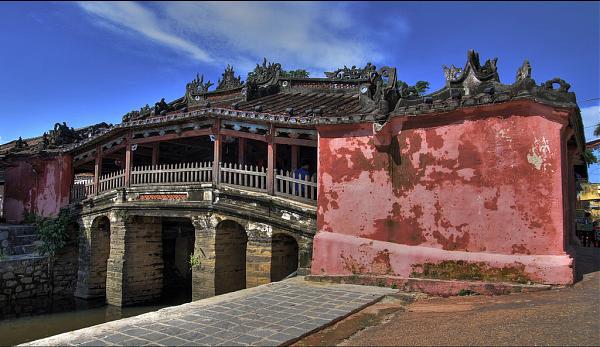
Mau Dich Pottery Museum.
- Address: 80 Tran Phu Street, Hoi An, Quang Nam.
The Mau Dich Pottery Museum is a simple two-story wooden house located on the central street of the ancient town. Its rustic design exudes a calm and peaceful atmosphere, just like the local people living here.
The museum houses more than 400 artifacts found at archaeological sites in Hoi An. These ancient artifacts vividly reflect the thriving pottery trade on the international seaport of Hoi An.
Hoi An Silk Village.
- Address: 28 Nguyen Tat Thanh Street, Tan An, Hoi An, Quang Nam.
- Opening hours: 8:00 AM – 9:00 PM.
- Ticket price: 50,000 VND/person.
Hoi An Silk Village is a place that revives, preserves, and develops the traditional silk cultivation and hand-weaving craft of Quang region. It preserves the traditional silk weaving techniques with various looms dating back to ancient times.
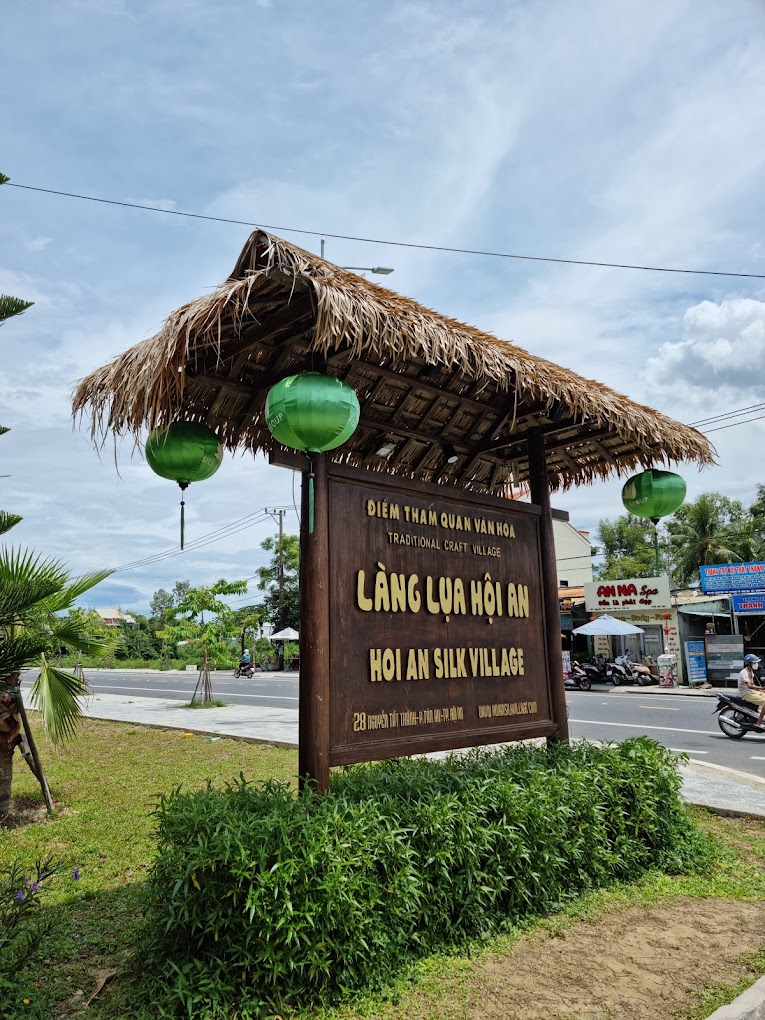
At the silk village, you’ll have the opportunity to witness and learn about the entire process from harvesting mulberry leaves for silkworms to the stages of silk cultivation and weaving, done by skillful and talented artisans.
Today, the Hoi An Silk Village is one of the attractions in the ancient town, where you can also purchase high-quality, vibrant, and delicate silk products.
Hoi An Night Market.
- Address: Nguyen Hoang Street, Hoi An, Quang Nam.
The Hoi An Night Market is located opposite the Bridge Pagoda. In the evening, the market attracts a large number of visitors who come to stroll, shop, and enjoy local specialties.
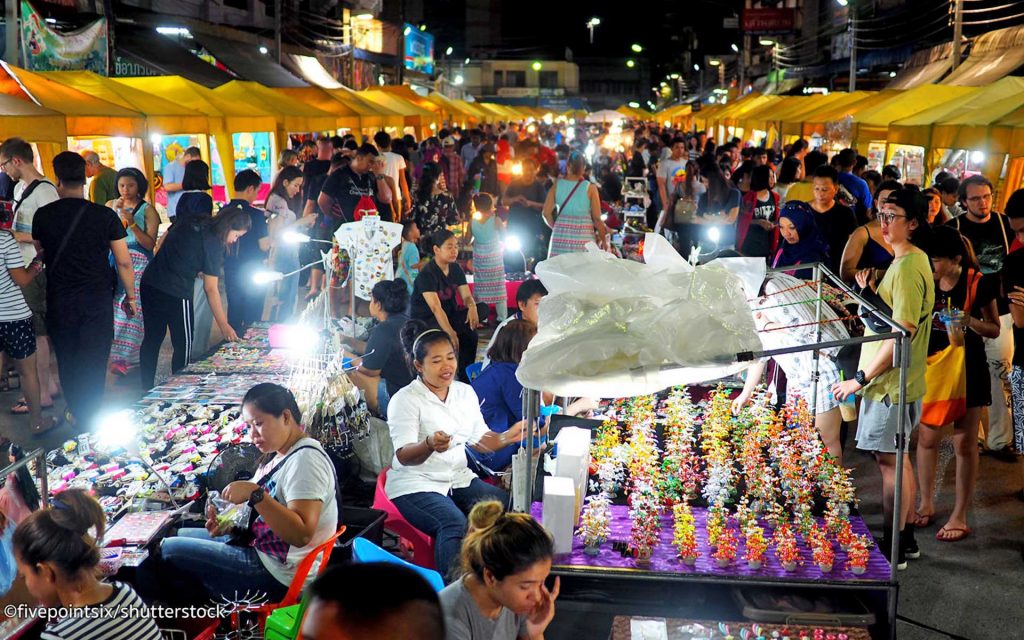
Tan Ky Ancient House.
- Address: 101 Nguyen Thai Hoc Street, Hoi An, Quang Nam.
In addition to the assembly halls, the ancient town also features a system of beautiful ancient houses that will surely leave you in awe when visiting.
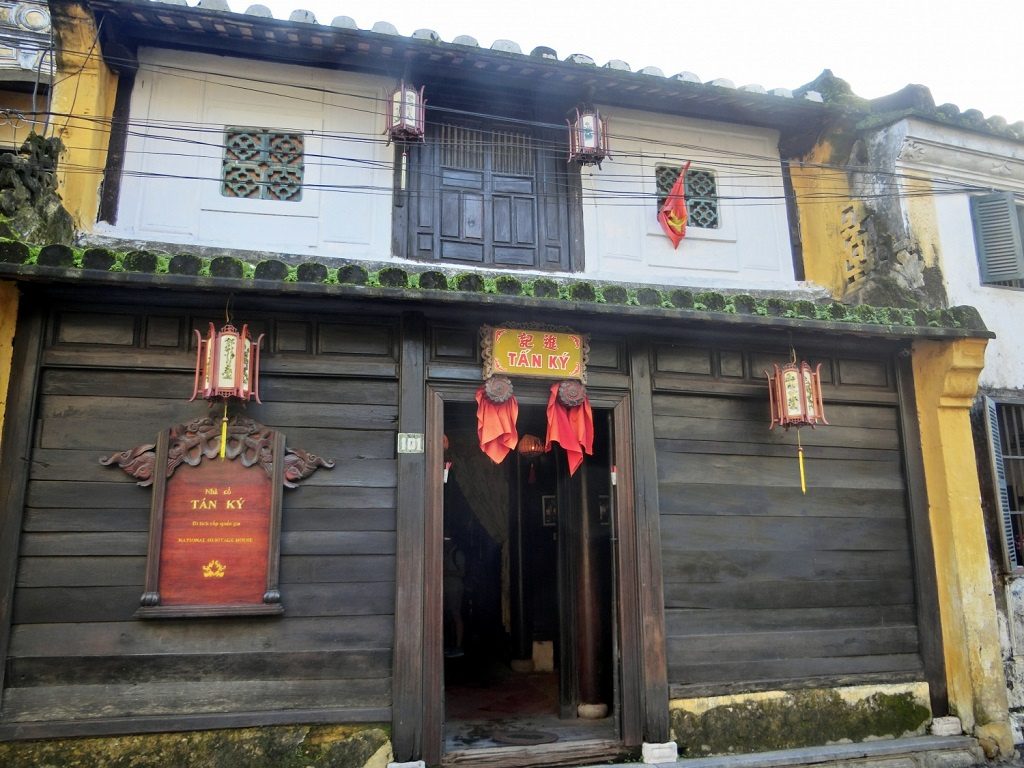
Among them, Tan Ky Ancient House is renowned as the most beautiful ancient house in Hoi An. It was the first house to be honored as a National Heritage and is considered a “living museum” that preserves the intact architectural features of ancient Hoi An houses. It has been home to 7 generations of the Le family.
What to buy as souvenirs after visiting the assembly halls in Hoi An.
To preserve beautiful moments and memorable experiences after each trip, besides capturing videos and photos, you can also buy local specialties or souvenirs to bring back as mementos. DanangPrivateCar.com will suggest some gifts you should buy when traveling and exploring Hoi An.
Souvenirs and handicrafts.
When traveling, small and meaningful souvenirs are always a must as gifts for your family and friends. In Hoi An, you can easily find and purchase souvenirs such as lanterns, toys, or small accessories like embroidered bags, rattan bags, silk products, and jewelry. They are available in various shops and markets throughout Hoi An.
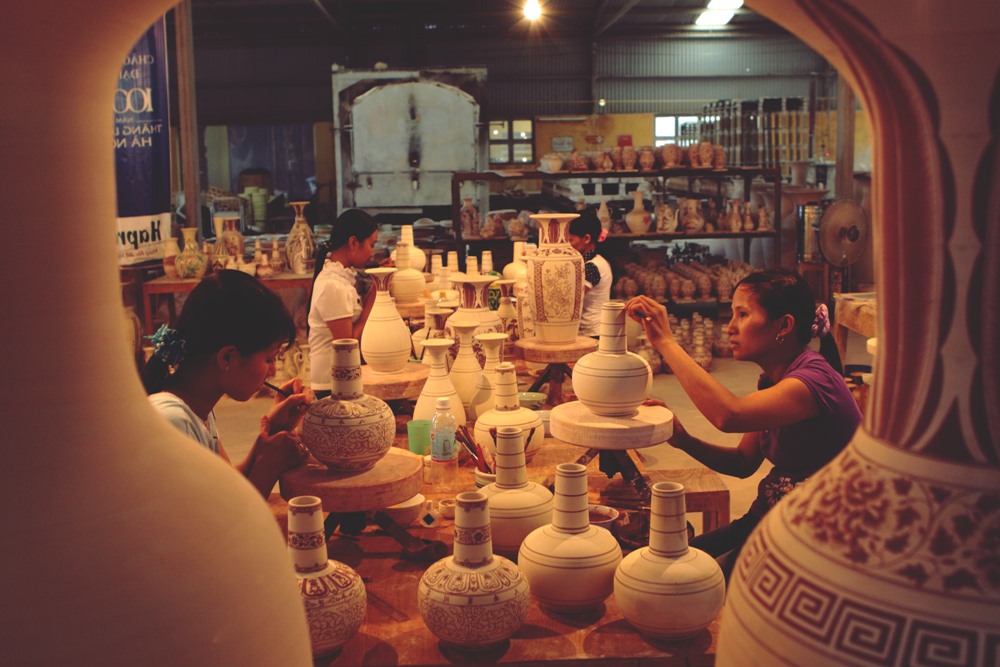
Hoi An Green Bean Cakes.
Hoi An Green Bean Cakes are popular traditional snacks loved by the locals in the ancient town. Different from the Green Bean Cakes in Hai Duong, Hoi An Green Bean Cakes come in various shapes and fillings. Among them, green bean cakes filled with pork are divided into two types: wet and dry.
Each Hoi An Green Bean Cake is a perfect blend of soft, sweet-smelling green bean filling and rich and fatty pork filling.
Tò He (Toy Figurines).
Tò He in Hoi An originates from China. When the Chinese people settled in Hoi An, they brought with them the recipe to make these figurines, which became popular in Hoi An and Quang Nam.
The main ingredients for Tò He are brown sugar, fresh ginger, white sesame seeds, and the outer wrapping is made of banana leaves. Locals usually use Tò He as offerings during festivals and holidays.
The Top 5 assembly halls in Hoi An boast unique architectural beauty and historical culture that will surely leave tourists satisfied when visiting. It won’t take too much time to explore all 5 assembly halls in the ancient town, but the experiences, impressions, and emotions gathered from the visit will undoubtedly be very special and memorable!

